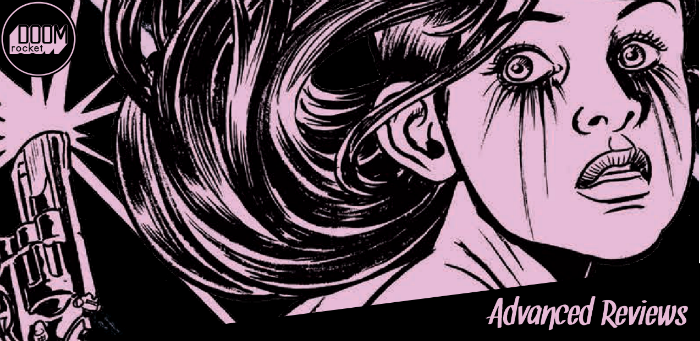Are you looking forward to a new comic book but it’s impossible for you to wait for its release before you know what we thought about it? That’s why there’s DoomRocket’s Advanced Reviews — now we assess books you can’t even buy yet. This week: ‘Lodger’ #1, out October 24 from Black Crown and IDW Publishing.
THIS ADVANCE REVIEW OF ‘LODGER’ #1 IS SPOILER-FREE.
by Jarrod Jones. Director Jean-Luc Godard once coined a phrase by stating the obvious: “All you need for a movie is a gun and a girl.” I wouldn’t presume to speculate what he might make of Lodger #1, but gauging from the premise alone—where a young girl stalks a serial killer’s path of bloodshed with naught but a snub-nose revolver and the desire to use it—the famously cantankerous filmmaker might, at the very least, readjust his tinted spectacles as a response.
Lodger is precisely what you’d expect considering its pedigree. A girl. A gun. A target. Simplicity itself. A noir comic from The Laphams, David and María, who as luck would have it happen to be masters of comics noir. As for the mood, think “Stray Bullets hits the road.” Eisner-level sequentials that feel real and fight dirty. It’s the sort of lean, economic storytelling we’ve come to appreciate from this duo, another killer example of the Lapham’s often emulated, never exceeded, accept-no-bullshit style.
The young girl I mentioned is a very Lapham-ian lead, in way over her head but encrusted with enough emotional armor to survive any sort of bloody obstacle that comes her way. Her major roadblock in this issue feels almost like a trifle compared to what is likely waiting for her in the pages to come. And naturally she has an equally Lapham-ian moniker: Folks, meet Ricky Toledo, the latest marquee star of Shelly Bond’s riotously fantastic boutique label, Black Crown. She’ll fit right in.
In this revenge yarn 18 year-old Ricky hunts a serial killer who operates as a travel blogger called “The Lodger”. Once he rented a room from her mother and father and soon after murdered them.
Like I said, simple. But The Lodger left a lasting impression on Ricky, and later, he leaves one on the reader. The bits that work best are when María & David set the killer’s jet-black musings on the quaint ordinariness of the issue’s tiny, roadside town—Blossom, Michigan—against visuals that capture its painfully ordinary realities. Slices of rural monotony that later only barely obscure the mayhem underneath.
I want to know more about the people who populate Blossom because there’s so much of this town in this issue. The loud old lady at the local pharmacy who seems to be loitering but you don’t know for sure. The asshole cops who don’t seem too shaken by this sudden burst of violence. (“When it rains, it pours,” one says.) The Penny For a Dollar shop. That pharmacy again, Hitch’s, where the homemade ice cream is so darn good it will melt all your problems away. Small towns (and the stories about them) live and die on the connection and vitality of its people. That’s what makes this issue work so well. A marauding loner like the Lodger thinks these people and their lives are “quaint.” Fodder for his blog, lambs for his slaughter. I can’t wait to see Ricky kick the shit out him.
The killer’s published words, which run throughout the issue, are especially chilling when they begin to shift in tone. Later, as Ricky furthers her investigation, the Lodger’s recounting of his visit to the quiet hamlet takes on a disturbing bent as we soon suss out the writer is clearly engaging with the familiar urge to kill again. We know in the back of our minds that behind his eerie educated plainness lies something far more sinister, but I wasn’t prepared for the convergence of the book’s savagery and the ice-cold veneer of the Lodger’s broodings, how they came together to sock me square in the gut. Moments like this make Lodger brilliant.
I often found myself scanning the book’s black and white visuals, the tempo of David’s iconic eight-panel grid, for any musical connection. After all, Black Crown is a synthesis of sonic atmosphere and high-minded comic bookery. And there’s also a precedent to consider here: When David Lapham and Shelly Bond were putting together Young Liars all those years ago, Lou Reed’s “Take A Walk On The Wild Side” was used as the launching motif. There aren’t any obvious musical signposts here. But for this hard-edged Mid-Western, my Michigander brain dredged up tracks from Ann Arbor and Detroit music titans like The Stooges and The Dirtbombs. I found the primitive, raw edges of this music fit snugly within the contours of the dull razor cuts Logder #1 left on me. It made this the most visceral experience I’ve had yet with Black Crown.
Black Crown/IDW Publishing/$3.99
Written by David & María Lapham.
Art by David Lapham.
Edited by Shelly Bond.
9.5 out of 10





















